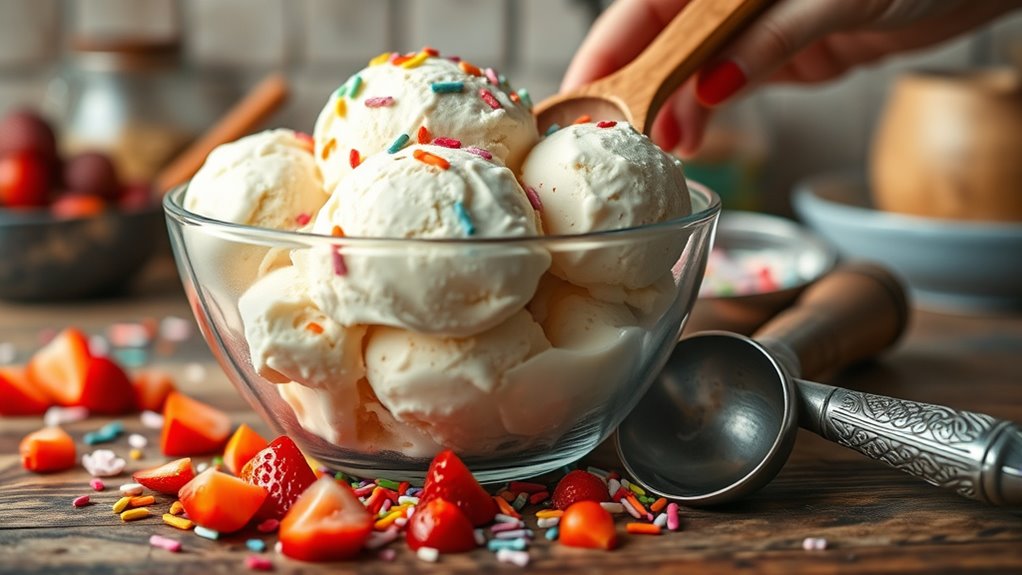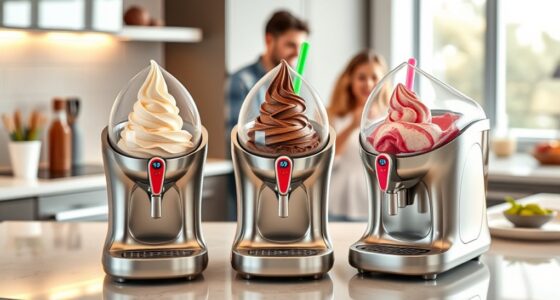More people are ditching store-bought ice cream because making it at home lets you control ingredients, cut artificial additives, and create healthier choices. You can experiment with flavors, use fresh ingredients, and customize toppings, making it more fun and rewarding. Plus, homemade ice cream saves money over time and reduces packaging waste, which benefits the environment. Want to discover how these benefits come together? Keep exploring to learn more.
Key Takeaways
- Homemade ice cream allows full control over ingredients, reducing artificial additives and preservatives for a healthier treat.
- Personalization with fresh fruits, herbs, and toppings creates unique, flavorful, and customizable desserts.
- Making ice cream at home is more cost-effective and environmentally friendly, minimizing packaging waste.
- Using local ingredients supports sustainable farming and decreases the carbon footprint of store-bought options.
- Freshly made ice cream offers superior taste and quality, free from artificial flavors and preservatives.
Health Benefits of Making Your Own Ice Cream

Making your own ice cream allows you to control the ingredients, which can lead to healthier choices. You can select dairy alternatives like almond milk or coconut milk to reduce saturated fat and accommodate dietary restrictions. This way, you avoid the preservatives and artificial additives often found in store-bought options. Additionally, homemade ice cream lets you manage calorie control by adjusting sugar levels and portion sizes. You can use natural sweeteners or reduce sugar altogether, making it a better choice for your health. Preparing ice cream at home also encourages mindful eating, helping you stay aware of what you consume. Incorporating healthy ingredients into your recipes can further enhance the nutritional value of your homemade treats. Moreover, experimenting with nutrient-rich additions like fruits, nuts, or seeds can boost the health benefits of your ice cream. Overall, making ice cream yourself empowers you to enjoy a delicious treat while maintaining a healthier lifestyle.
Customization and Unique Flavors
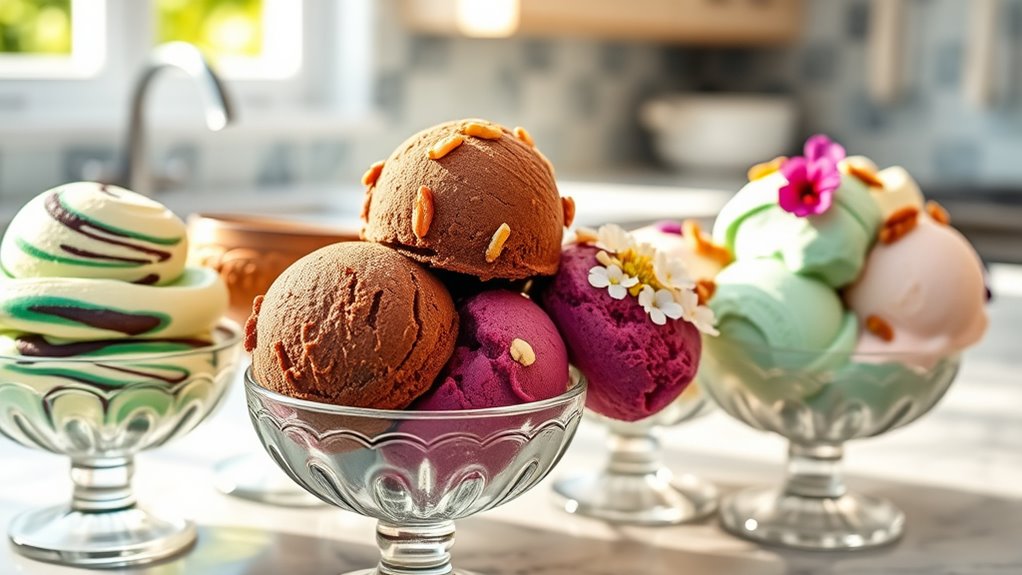
Creating your own ice cream opens up exciting possibilities for customization and unique flavors that you won’t find in store-bought varieties. You can experiment with custom flavoring by blending ingredients like fresh fruit, spices, or even herbs to craft a taste that’s completely your own. This flexibility allows you to match your mood or seasonal themes perfectly. Plus, personalized toppings let you add crunch, sweetness, or texture exactly how you like. Think chopped nuts, chocolate chips, or fresh fruit slices—whatever makes your creation special. Making ice cream at home gives you full control over every flavor detail, ensuring your dessert stands out and reflects your personal taste. Developing your own recipes can also boost your critical thinking skills as you experiment with different combinations and techniques. Incorporating food safety practices ensures your homemade ice cream is both delicious and safe to enjoy. It’s a fun, creative way to elevate your ice cream experience beyond the ordinary and embrace the joy of culinary experimentation.
Cost-Effectiveness Over Time
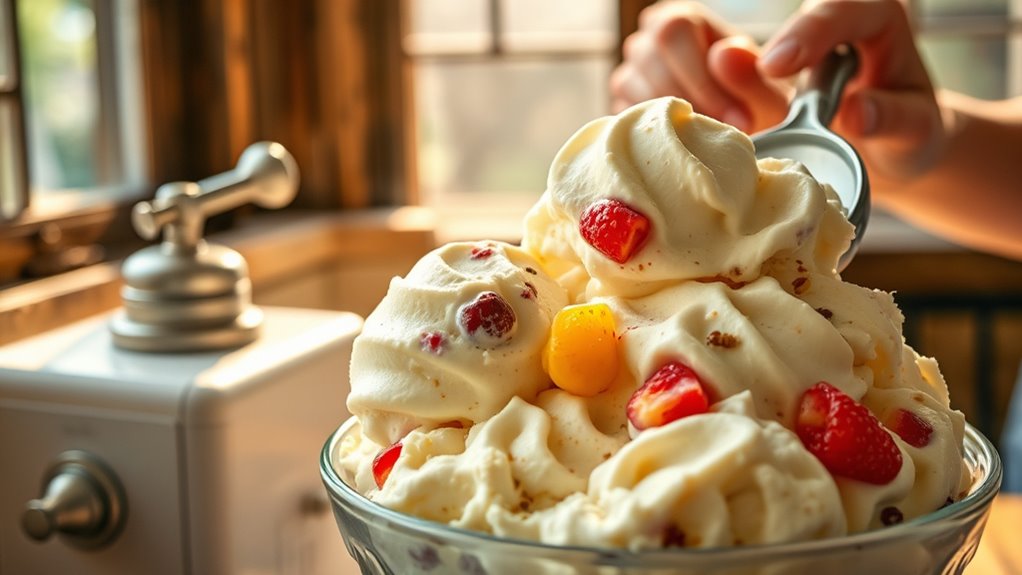
Although it may require an upfront investment, homemade ice cream can be more cost-effective in the long run. By making your own, you’ll see significant cost savings over time compared to constantly buying store-bought pints. Here are three ways it pays off:
- Reduced per-serving cost — bulk ingredients last longer, lowering overall expenses.
- Fewer additives and preservatives — saving money on unnecessary additives and frequent purchases.
- Long-term investment — quality ingredients and reusable equipment save money over multiple batches.
- Customization options mimic Home Decor upgrades, allowing for tailored flavors and textures without extra costs. Additionally, using home ice cream makers designed for durability can further enhance your savings and efficiency. Incorporating automated kitchen appliances can streamline the process and reduce labor time. Choosing energy-efficient appliances can also contribute to savings by reducing electricity consumption.
In the end, your initial investment in equipment and ingredients becomes a smart financial move, providing ongoing savings. Over time, making ice cream at home isn’t just more delicious — it’s a smarter, more economical choice.
Control Over Ingredients and Additives
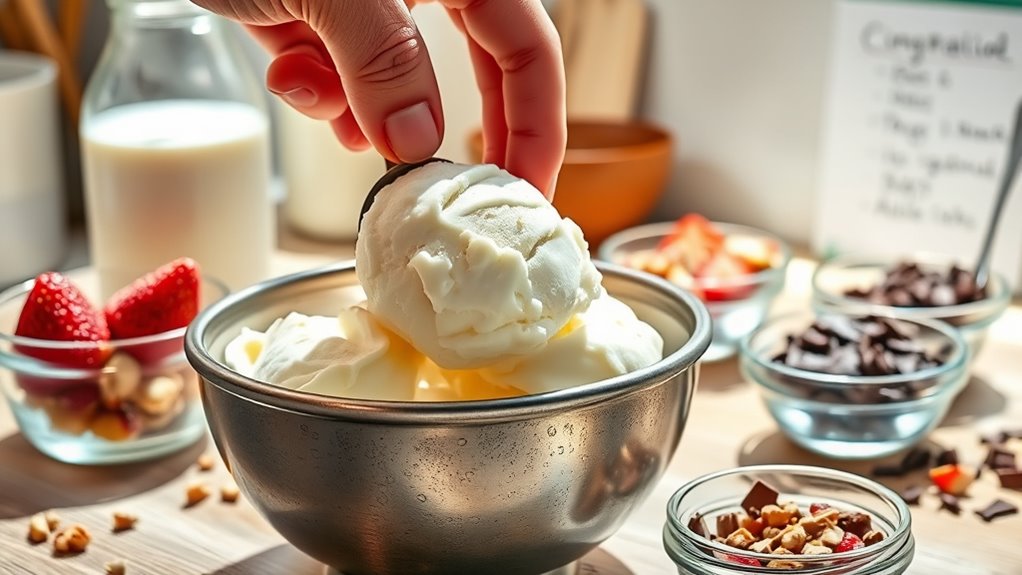
By making your own ice cream, you gain full control over what goes into it. You can choose ingredient transparency, ensuring each component is natural and high-quality. This allows you to avoid unwanted additives often found in store-bought options, like preservatives, artificial flavors, or stabilizers. With homemade ice cream, you decide exactly what’s in your treat, supporting healthier choices and dietary restrictions. Here’s a simple comparison:
| Ingredient Transparency | Additive Avoidance | Control Over Flavors |
|---|---|---|
| Know every ingredient | Skip artificial additives | Customize flavors to your liking |
| Use fresh, natural ingredients | Avoid preservatives | Mix in fresh fruit or herbs |
| No hidden fillers | Limit processed components | Experiment freely |
This control makes your ice cream healthier and more satisfying. Additionally, choosing quality ingredients can further elevate the taste and nutritional value of your homemade creation. Incorporating reliable kitchen tools can also enhance your preparation process, making it easier to achieve perfect results every time. Using proper freezing techniques can help ensure your ice cream has the ideal texture and consistency. Furthermore, understanding proper storage methods can keep your ice cream fresh and prevent freezer burn, ensuring a delightful experience with every scoop.
Fun and Engaging Experience in the Kitchen

Making ice cream together sparks creativity as you experiment with unique flavor combinations. It’s a chance to turn the kitchen into a fun workshop, full of laughs and surprises. Plus, sharing the process strengthens family bonds and creates lasting memories. Additionally, involving kids in the process can help introduce them to healthy ingredients early on, making it both a fun and educational activity. Embracing a farmhouse vibe in your kitchen can also inspire the use of natural ingredients and rustic presentation styles that make homemade ice cream feel even more special. Considering the regional availability of ingredients can further enhance the authenticity and flavor of your homemade creations. Incorporating continuous learning about new recipes and techniques can keep your ice cream adventures exciting and innovative. For example, exploring different flavor combinations can elevate your homemade treats to new heights.
Creative Flavor Combinations
Creating your own ice cream flavors opens up a world of playful experimentation in the kitchen. You can blend unexpected ingredients, turning simple scoops into edible art. Think about how artistic plating enhances the visual appeal, making each serving a masterpiece. Experiment with flavor pairing—pair sweet and savory, tart and spicy—to surprise your palate. Here are some ideas to spark your creativity:
- Match ripe strawberries with basil and a touch of balsamic glaze
- Combine dark chocolate with chili flakes and sea salt
- Mix coconut milk with lychee and a hint of ginger
- Incorporate core personality traits to inspire unique flavor combinations that reflect your individual taste and style.
Family Bonding Moments
Sharing recipes and swapping stories, you create lasting memories in the kitchen. This activity encourages teamwork—measuring ingredients, stirring, and tasting—strengthening your connection. It’s also a perfect opportunity for storytelling moments, where everyone’s voice counts. Here’s a deeper look at what makes these moments special: You can also learn about emotional manipulation and how to recognize it, which can be helpful if family members or friends are involved in difficult relationships. Incorporating portable camping gear into outdoor gatherings can enhance these bonding experiences by making them more comfortable and convenient, whether it’s cooking over a portable stove or sharing treats with portable coolers. Practicing mindfulness during these activities can further enrich the experience, fostering a sense of mental clarity and presence. Additionally, understanding skin health and sun safety tips can help ensure everyone’s well-being while enjoying outdoor activities. Developing leadership skills through shared activities can also promote better cooperation and a sense of collective achievement among family members.
Environmental Impact and Sustainability
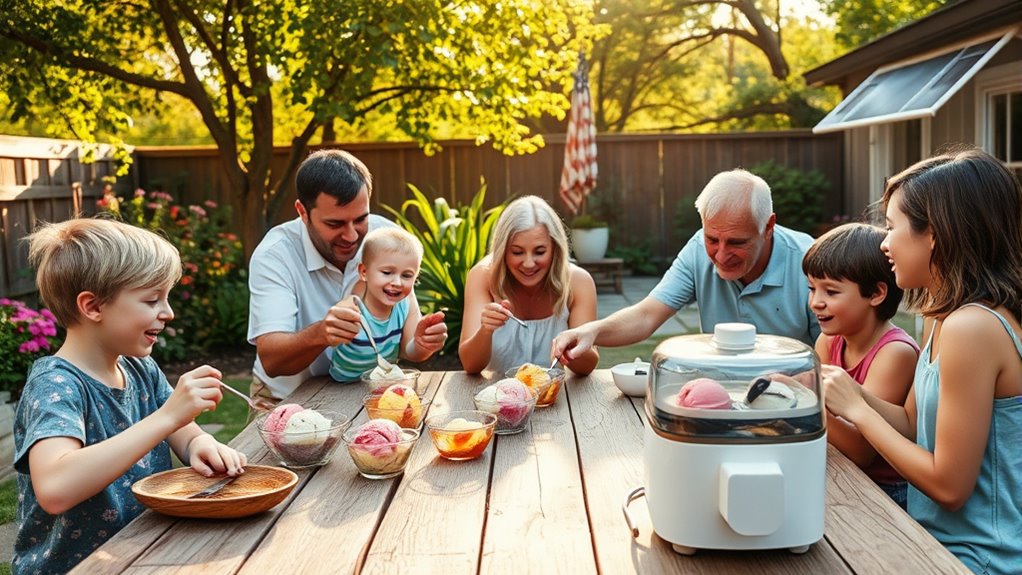
Making ice cream at home helps cut down on packaging waste and reduces your carbon footprint. When you choose local ingredients, you support nearby farms and lessen transportation emissions. Small changes like these can make a big difference for the environment.
Reducing Packaging Waste
Reducing packaging waste is essential for minimizing the environmental impact of homemade ice cream. By making your own, you cut down on single-use containers and packaging that often end up in landfills. To enhance waste reduction, consider these strategies:
- Use reusable containers for storing and freezing your ice cream, avoiding disposable cartons.
- Repurpose glass jars or metal tins instead of buying new packaging.
- Support recycling efforts by properly sorting and cleaning your containers to ensure they’re recycled effectively.
These small changes make a big difference in reducing waste and lowering your ecological footprint. Homemade ice cream not only tastes better but also helps protect the environment by decreasing packaging waste, promoting sustainability with every batch you create.
Lower Carbon Footprint
By choosing to make your own ice cream and use reusable containers, you not only cut down on waste but also lower your carbon footprint. Homemade ice cream reduces the need for store-bought options that often come with excessive packaging. Using eco-friendly equipment like hand-crank or electric ice cream makers minimizes energy consumption compared to industrial machines. Additionally, opting for recyclable packaging whenever you need to store leftovers or transport your ice cream helps lessen landfill waste. Making your own ice cream allows you to control ingredients and waste, decreasing the environmental impact associated with manufacturing and transportation. Overall, your choices support sustainability by reducing reliance on single-use plastics and energy-intensive processes, making homemade ice cream a greener, more eco-conscious option.
Supporting Local Farms
Supporting local farms directly benefits the environment by decreasing the carbon emissions associated with transportation and large-scale industrial agriculture. When you choose local sourcing, you diminish the need for long-distance shipping, lowering your carbon footprint. Building farm partnerships guarantees fresh, sustainable ingredients, promoting eco-friendly farming practices.
Consider these benefits:
- Reduced greenhouse gas emissions through shorter supply chains
- Encouragement of sustainable farming techniques
- Support for local economies and community resilience
Freshness and Superior Taste
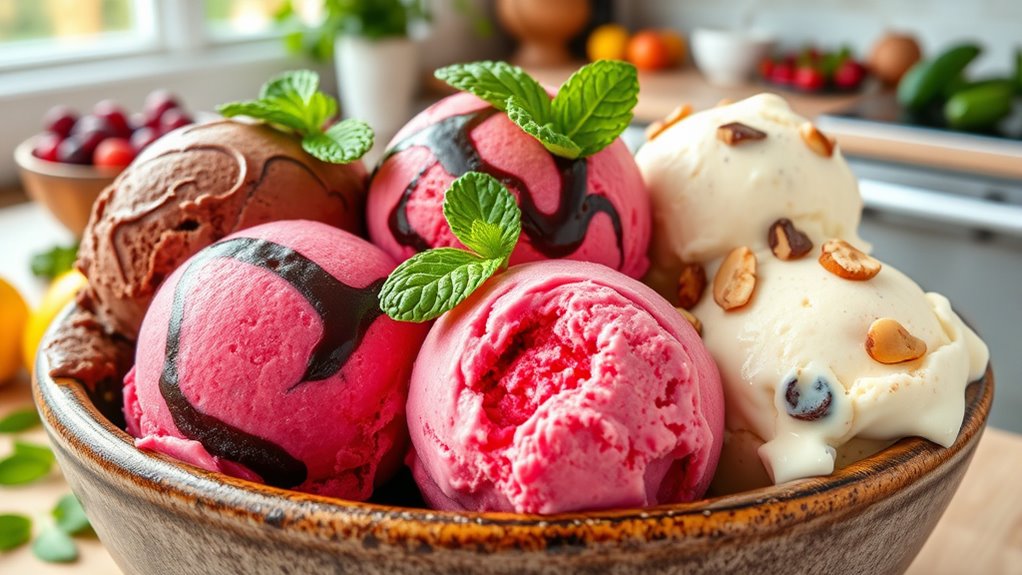
Freshness is the secret behind homemade ice cream’s superior taste, as you control every ingredient from start to finish. Unlike commercial manufacturing, where ice cream often sits in storage for weeks, you use fresh dairy, fruits, and flavorings, ensuring best taste and quality. Proper ice cream storage at home keeps your creations at their peak, preventing freezer burn and preserving flavor. This direct control means you avoid artificial additives and excessive preservatives common in store-bought options. The result is a richer, more vibrant flavor that immediately satisfies your palate. Plus, you can experiment with unique ingredients to craft personalized flavors. Ultimately, fresh, homemade ice cream provides a taste experience that’s far superior to mass-produced varieties, making every scoop a delicious reminder of your skill and care.
Frequently Asked Questions
How Long Does Homemade Ice Cream Typically Last in the Freezer?
Homemade ice cream typically lasts about 2 to 4 weeks in the freezer if stored properly. To maximize freezer duration, use airtight containers and leave some space for expansion. Storage tips include sealing tightly and labeling with date. Keep your ice cream at a consistent freezing temperature to prevent freezer burn and maintain flavor. Enjoy it within this timeframe for the best taste and texture.
Are There Any Safety Concerns With Homemade Ice Cream Recipes?
You should always prioritize food safety when making homemade ice cream by using fresh ingredients and proper hygiene. Guarantee your ingredients are fresh to prevent bacteria growth, and keep your freezer at the right temperature. Avoid cross-contamination by sanitizing utensils and containers. If you notice any off smells or textures, discard the batch. Following these steps helps keep your homemade ice cream safe and delicious for everyone to enjoy.
What Equipment Is Essential for Making Ice Cream at Home?
To make ice cream at home, you need a few essential tools. An ice cream churn is key for achieving that smooth, creamy texture, as it stirs and freezes your mixture evenly. You’ll also need mixing bowls to combine ingredients thoroughly. While some recipes require a freezer-safe container, the churn takes care of most of the hard work, transforming simple ingredients into delicious homemade ice cream effortlessly.
Can Homemade Ice Cream Be Made Dairy-Free or Vegan?
You can easily make homemade ice cream dairy-free and vegan. Just swap traditional dairy with dairy-free options like coconut milk, almond milk, or cashew cream. Use vegan substitutions such as agave syrup or maple syrup for sweetness, and choose plant-based ingredients for flavorings. By customizing your ingredients, you get delicious, creamy ice cream without dairy or animal products, satisfying your cravings while staying true to your lifestyle choices.
How Can I Store Homemade Ice Cream to Prevent Ice Crystals?
To prevent ice crystals in your homemade ice cream, store it properly by using an airtight container, preferably one with a tight-fitting lid, to minimize air bubble formation. Avoid leaving gaps that allow air in, which causes crystals. Choose a container material like plastic or metal that conducts cold evenly. Regularly check and reseal to maintain freshness, ensuring your ice cream stays smooth and creamy every time you enjoy it.
Conclusion
As you embrace homemade ice cream, you’re gently guiding yourself toward sweeter moments and healthier choices. While store-bought options may seem tempting, crafting your own offers a subtle, satisfying sense of accomplishment and control. In this small act, you nurture not just your taste buds but also a mindful connection to what you enjoy. Sometimes, the quiet joy of making something yourself reveals more than any store-bought treat ever could.
